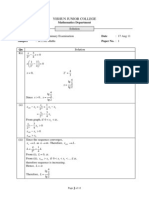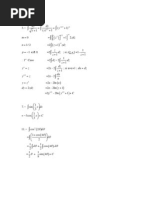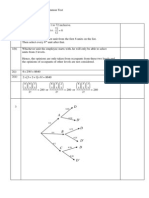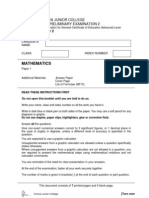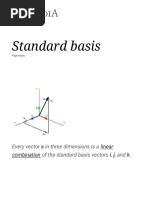QN Solution 1: H2 Math Paper 1
QN Solution 1: H2 Math Paper 1
Uploaded by
Alex SoonCopyright:
Available Formats
QN Solution 1: H2 Math Paper 1
QN Solution 1: H2 Math Paper 1
Uploaded by
Alex SoonOriginal Description:
Original Title
Copyright
Available Formats
Share this document
Did you find this document useful?
Is this content inappropriate?
Copyright:
Available Formats
QN Solution 1: H2 Math Paper 1
QN Solution 1: H2 Math Paper 1
Uploaded by
Alex SoonCopyright:
Available Formats
1
2009 Innova Junior College Prelim Exam 2 H2 Math Paper 1 solution
Qn Solution
1 1
st
group: 2 0.35 3 200.88 a b c + + = --- (1)
2
nd
group: 5 2 4.65 404.52 a b c + + = --- (2)
3
rd
group: 0.9 2 153.12 a b c + + = --- (3)
Using GC, 20.8, 36.8, 48.8 a b c = = =
2 (i)
(ii)
sin sin
2 2
d 1
(e ) cos e
d 2 2
x x
x
x
=
sin
2
sin e d
x
x x
}
=
sin
2
2sin cos e d
2 2
x
x x
x
}
=
sin sin
2 2
4sin e 2cos e d
2 2
x x
x x
x
}
=
sin sin
2 2
4sin e 4e
2
x x
x
C +
3 (i)
(ii)
5 4
* 0 z z z =
5 4
* z z z =
6 4
4 2
6
6
* z z z z
z z
z
r
=
=
=
=
Since
6
r
is real,
6
z
is real.
( )
6
6 i 6
e z r r
o
= =
i6
e 1
o
=
i6 i 2
e e
k o t
=
where
0, 1, 2, 3 k =
3
kt
o =
Since
0
2
o < <
,
3
o =
.
3(i)
Alternatively,
5 4
* 0 z z z =
( )
5 i5 4 i
e e 0 r r r
o o
=
i5 i
i6
e e 0
e 1 0
o o
o
=
=
2
(ii)
i6
e 1
o
=
6 6 i6 6
e z r r
o
= =
Since
6
r
is real,
6
z
is real.
i6
e 1
o
=
i6 i 2
e e
k o t
=
where
0, 1, 2, 3 k =
3
kt
o =
Since
0
2
o < <
,
3
o =
.
Alternatively for (ii),
since
0
2
o < <
, 0 6 3 o t < <
cos 6 1 and sin 6 0
6 2 and 6 , 2
and ,
3 6 3
o o
o t o t t
t t t
o o
= =
= =
= =
3
o =
4 (i)
(ii)
3
5
Let
n
P be the statement
2 1
2 2
n
n
u
n
=
+
, where 1 n > .
When n = 1, LHS =
1
1
6
u = (given) ,
RHS =
2 1 1
3 2 6
= .
LHS = RHS,
1
P is true.
Assume that
k
P is true for some 1 k > ,
i.e.
2 1
2 2
k
k
u
k
=
+
.
To prove:
1 k
P
+
is true,
i.e.
1
1
2 1
3 2
k
k
u
k
+
+
=
+
.
( )
( )( )
1
1 2
2 3
k
k k
k
u u
k k
+
+
= +
+ +
=
( )
( )( )
1 2
2 1
2 2 2 3
k
k
k
k k k
+
+
+ + +
=
( ) ( )
( )( )
3 2 1 2
1
2 3 2
k k
k k
k k
+ + +
+ +
=
( )
( )( )
2 3 1
1
2 3 2
k
k k
k k
+ + +
+ +
=
( )
( )( )
2 2 2
1
2 3 2
k
k
k k
+
+ +
=
1
2 1
3 2
k
k
+
+
k
P is true
1 k
P
+
is true.
Since
1
P is true and
k
P is true
1 k
P
+
is true, by mathematical induction,
n
P
is true for all 1 n > .
2 1
2 2
n
n
u
n
=
+
1
2
2 1 0
2
n
n
u
n
+
+ = >
+
(
1
2 0
n+
> , n + 2 > 0 for all
1 n > )
6
x
y e z
t
=
x x
dy dz
e ze
dx dx
t t
t = +
2 2 2
3
x x x x x
dz
e ze e z e e z
dx
t t t t t
t t + = +
2
1 3
x x x x
dz
e ze e z e z
dx
t t t t
t t + = +
4
2
1 3
x x
dz
e e z
dx
t t
=
2
1 3
dz
z
dx
=
2
1
1
1 3
dz dx
z
=
} }
( )
1
1
sin 3
3
z x C
= +
When 0 x = ,
1
2
y = ,
1
2
z =
3 3
C
t
=
( )
1
1
sin 3
3 3 3
z x
t
= +
1
sin 3
3 3
z x
t | |
= +
|
\ .
sin 3
3 3
x
e
y x
t
t | |
= +
|
\ .
7
( ) ( )
1
2
3
2
1 1 1 2
1 1 ......
3 2! 3 3
1 1
1 .....
3 9
x x x
x x
| |
= + +
|
\ .
= +
( ) ( )
1
2
3
2
1 1 1 4
1 2 1 (2 ) 2 ......
3 2! 3 3
2 8
1 .....
3 9
x x x
x x
| || |
+ = + +
| |
\ .\ .
= + +
1
1 1
3
3 3
2 2
2
1
(1 ) (1 2 )
1 2
1 1 2 8
1 ..... 1 .....
3 9 3 9
1 .....
x
x x
x
x x x x
x x
| |
=
|
+
\ .
| || |
= + + +
| |
\ .\ .
= + +
For expansion to be valid,
1
1
x
x
<
<
and
2 1
1
2
x
x
<
<
1 1 1
or
2 2 2
x x < < <
Both values of x are within the range of values of x.
1
6
x = will give a better
approximation as it is closer to zero.
Subst
1
6
x = ,
5
1 1
3 3
1
3
1 5
1
6 6
2 8
1
6 6
5
8
| | | |
| |
=
| |
| |
+
\ . \ .
| |
=
|
\ .
( )
1
2
3
1
3
5 1 1
1 .....
8 6 6
1 1
5 2 1
6 36
31
18
| | | | | |
= + +
| | |
\ . \ . \ .
| |
~ +
|
\ .
~
8
2
1
2 5
n n
u u n n
+
= +
1 0
u u =
( ) ( ) ( ) ( )
2 2
2 1 0
2 1 5 1 2 1 5 1 u u u = + = +
( ) ( )
( )
( )
2
2 2
3 2 0
2 2 5 2 2 1 2 5 1 2 u u u = + = + + +
( ) ( )
( )
( )
2
2 2 2
4 3 0
2 3 5 3 2 1 2 3 5 1 2 3 u u u = + = + + + + +
( )
( )
2
2 2 2
0
2 1 2 3 1
n
u u n = + + + + +
( ) ( )
5 1 2 3 1 n + + +
=
1 1
2
0
1 1
2 5
n n
r r
u r r
= =
+
= ( ) ( )
( )
( )
0
1
1
2 1 2 1 5 1 1
6 2
n
u n n n n
+ +
= ( )( )
0
1
1 4 17
6
u n n n +
1
6
k =
Alternative method
2
1
2 5
n n
u u n n
+
=
( )
( )
1 1
2
1
0 0
2 5
n n
r r
r r
u u r r
+
= =
=
1 1
2
1 1
2 5
n n
r r
r r
= =
=
1 0
u u
+
2 1
u u
+
3 2
u u
+
+
1 n n
u u
=
0 n
u u
0 n
u u = ( ) ( )
( )
( )
1
1
2 1 2 1 5 1 1
6 2
n
n n n n
+
6
= ( )( )
1
1 4 17
6
n n n
( )( )
0
1
1 4 17
6
n
u u n n n = + ,
1
6
k =
0
10 u =
( )( )
1
10 1 4 17
6
n
u n n n = +
From GC,
16
1890 u = < 2 000
17
2 322 u = > 2 000
it takes 17 days for the number of bacteria to first exceed 2 000.
Alternatively,
( )( )
1
10 1 4 17 2000
6
n
u n n n = + >
n > 16.3
Required no. of days = 17
9
( ) sin ln 1 3 y x ( =
( )
( ) ( )
d 3
cos ln 1 3
d 1 3
d
1 3 3cos ln 1 3
d
y
x
x x
y
x x
x
| |
( =
|
\ .
( =
Diff. wrt x
( ) ( )
( )
( )
2
2
2
2
2
2
2
2
d d 3
1 3 3 3sin ln 1 3
d 1 3
d
d d
1 3 3(1 3 ) 9
d
d
d d
1 3 3(1 3 ) 9 0 (shown)
d
d
y y
x x
x x
x
y y
x x y
x
x
y y
x x y
x
x
| |
( =
|
\ .
=
+ =
Diff. wrt x
( ) ( )
3 2
2
3 2
d d d
1 3 9 1 3 18 0
d
d d
y y y
x x
x
x x
+ =
When x = 0, 0 y = ,
d
3
d
y
x
= ,
2
2
d
9
d
y
x
= ,
3
3
d
27
d
y
x
=
( )
2
3
2 3
27
3 9
2 3!
9 9
3
2 2
x
y x x
x x x
=
~
16.3
2000
7
From ( )
d 3
cos ln 1 3
d 1 3
y
x
x x
| |
( =
|
\ .
,
( ) ( )
( ) ( )
d
1 3 3cos ln 1 3
d
d 1
cos ln 1 3 1 3
3 d
y
x x
x
y
x x
x
( =
( =
( ) ( )
2
2
1 27
cos ln 1 3 1 3 3 9
3 2
9
1
2
x x x x
x
| |
( ~
|
\ .
~
10
(i)
( )
1
f ( ) 2tan 2 x x x
=
'
2
4
f ( ) 1
1 4
x
x
=
+
2
2
2
2
3
0
4
1 1 4 4
1 1
1
4
1 4
4
1 4
1 4
x
x
x
x
s <
s + <
< s
+
< s
+
Since
2
4
1 4
1 4x
< s
+
,
2
4
1 0
1 4x
<
+
,
'
f ( ) 0 x <
So f ( ) x decreases when x increases.
(ii)
f
3 2 3 2
,
2 3 2 3
R
t t
| |
= +
|
|
\ .
Or
f
( 1.23,1.23) R =
(iii) For ff to exist,
f f
R D _
3 2 3 2
,
2 3 2 3
f
R
t t
| |
= +
|
|
\ .
or
f
( 1.23,1.23) R =
3 3
,
2 2
f
D
| |
=
|
|
\ .
or
g
( 0.866, 0.866) R =
f f
R D .
ff does not exist.
10
(iv)
Let ( )
1
2tan 2 y x x
=
8
Then ( )
1
2tan 2 x y y
=
10
(b)
2
h( ) 2 x x = +
( ) ( )
2
4 2 2
gh 2 5 1 4 x x x x = + = +
( ) ( )
2
2
g 2 2 3 4 x x
(
+ = + +
( ) ( )
2
g 3 4 x x = +
Alternatively,
2
h( ) 2 x x = +
( )
( )
( ) ( )
4 2
2
2 2 2
2
2 2
gh 2 5
2 4 4 2 5
2 6 2 13
x x x
x x x
x x
= +
= + +
= + + +
( )
2
g 6 13 x x x = +
11
(i)
( ) ( )
2 2
4 20 nx y nx y + + = ---- (1)
Diff. wrt. x
( ) ( )
d d
2 8 0
d d
y y
nx y n nx y n
x x
| | | |
+ + + =
| |
\ . \ .
d (3 5 )
d (5 3 )
y n y nx
x y nx
11
(ii)
For tangent // y-axis,
5 3 0
3
5
y nx
nx
y
=
=
Subst into (1)
2 2
3 3
4 20
5 5
1 5
2
nx nx
nx nx
x
n
| | | |
+ + =
| |
\ . \ .
| |
=
|
\ .
When
5
2
x
n
= ,
3
2
y =
When
5
2
x
n
= ,
3
2
y =
The coordinates are
5 3
,
2 2 n
| |
|
\ .
and
5 3
,
2 2 n
| |
|
\ .
(ii) Alternatively,
Subst
5
3
y
nx = into (1),
2 2
5 5
4 20
3 3
y y
y y
| | | |
+ + =
| |
\ . \ .
etc
9
11
(iii)
When curve cuts the x-axis, y = 0
( ) ( )
2 2
4 20
2
nx nx
x
n
+ =
=
For
2
x
n
= ,
2
2
5
d
2 d
3
5
3
n
y n
x
n
n
n
| |
|
\ .
=
| |
|
\ .
=
or
d ( 5 )
d 3
5
3
y n nx
x nx
n
=
Gradient of normal =
3
5n
Equation of normal at
2
, 0
n
| |
|
\ .
,
2
3 6
5
5
y x
n
n
= +
Equation of normal at
2
, 0
n
| |
|
\ .
,
2
3 6
5
5
y x
n
n
=
12(i)
common ratio of G = e
o
e e 1
o o
= < (since o < 0)
So G is convergent.
12
(ii)
e
1 e
S
o
=
+
Sum to infinity of even-numbered terms
=
1
2
e
1 e
o
o
+
1
2
e 1 e
3 1 e 1 e
o
o o
+
| |
=
|
+ \ .
e 1
3
1 e
ln 4
1
ln
4
o
o
o
=
=
=
12
(iii)
H:
1 1 2 1 3
e e e e
o o o + + +
+ + + +
Product of first n terms of H
=
( ) 1 1 1 1 2 1 3
e e e e e
n o o o o + + + +
=
( ) ( ) 2 1
2
e
n
n o +
=
( ) 2.03 0.03
2
e
n
n
O
x
y
1
10
( ) 2.03 0.03
2
e 15000
n
n
>
( ) 2.03 0.03 ln15000
2
n
n >
2
0.03 2.03 2ln15000 0 n n + <
11.39 < n < 56.275
Greatest value of n is 56.
Alternatively,
( ) 2.03 0.03
2
e 15000
n
n
>
11.39 < n < 56.275
Greatest value of n is 56.
13
(i)
5i 3j 2k DQ= +
Vector equation of line DQ,
0 5
3 3
0 2
3 (5 3 2 )
AD DQ
= +
| | | |
| |
= +
| |
| |
\ . \ .
= + +
r
j i j k
5i 3j 2k BS = + +
Vector equation of line BS,
5 ( 5 3 2 )
AB BS
= +
= + + +
r
j i j k
(ii) Let the angle between the lines DQ and BS be u
15000
11.39 56.275
( ) 2.03 0.03
2
e
n
n
y
=
11
1
cos
5 5
3 3 38 38 cos
2 2
30
cos 142.15
38
DQ BS DQ BS u
u
u
=
| | | |
| |
=
| |
| |
\ . \ .
| |
= =
|
\ .
Therefore, acute angle between the lines DQ and BS
180 142.15
37.9 (to1dp)
=
=
(iii)
5
BD BA AD = +
= i+3j
3 2
BR BC CR = +
= + j k
n
5 0 6
3 3 10
0 2 15
| | | | | |
| | |
= =
| | |
| | |
\ . \ . \ .
Equation of plane t,
6 5 6
10 0 10 30
15 0 15
| | | | | |
| | |
- = - =
| | |
| | |
\ . \ . \ .
r
(iv)
2
3
3
BX BC CX = +
= + j k
Shortest distance from X to the planet,
0 6
3 10
2 15
3
36 100 225
20
units
19
| |
|
| |
|
|
-
|
|
|
|
\ .
|
\ .
=
+ +
=
y = f ' (x)
You might also like
- Yjc h2 Math p1 SolutionsDocument12 pagesYjc h2 Math p1 SolutionsjimmytanlimlongNo ratings yet
- PJC h2 Math p1 SolutionsDocument13 pagesPJC h2 Math p1 SolutionsjimmytanlimlongNo ratings yet
- Rvhs h2 Math p1 SolutionsDocument13 pagesRvhs h2 Math p1 SolutionsjimmytanlimlongNo ratings yet
- Dhs h2 Math p2 SolutionDocument14 pagesDhs h2 Math p2 SolutionjimmytanlimlongNo ratings yet
- 2007 Ajc h2 Prelims Paper 1 SolutionsDocument9 pages2007 Ajc h2 Prelims Paper 1 Solutionsvincesee85No ratings yet
- ACJC 2014 H2 Maths Supp Exam (Solution For Students)Document9 pagesACJC 2014 H2 Maths Supp Exam (Solution For Students)RaymondZhangNo ratings yet
- Accenture Trade FinanceDocument12 pagesAccenture Trade FinanceAlex SoonNo ratings yet
- BT2 Revision Package Solutions (2008 Prelims)Document111 pagesBT2 Revision Package Solutions (2008 Prelims)gerwynngNo ratings yet
- Mi h2 Math Solutions p1Document10 pagesMi h2 Math Solutions p1jimmytanlimlongNo ratings yet
- HCI H2 Maths 2012 Prelim P1 SolutionsDocument12 pagesHCI H2 Maths 2012 Prelim P1 Solutionsnej200695No ratings yet
- JC2 Prelim H2 Math Solution Paper 1Document10 pagesJC2 Prelim H2 Math Solution Paper 1Huixin LimNo ratings yet
- 2013 - 2014 H2 Maths JJC Promo SolnsDocument11 pages2013 - 2014 H2 Maths JJC Promo SolnsLionel Torres LeeNo ratings yet
- AJC H2 Math 2013 Prelim P1 SolutionsDocument15 pagesAJC H2 Math 2013 Prelim P1 Solutionsnej200695No ratings yet
- NYJC JC 2 H2 Maths 2011 Mid Year Exam Solutions Paper 1Document10 pagesNYJC JC 2 H2 Maths 2011 Mid Year Exam Solutions Paper 1jimmytanlimlongNo ratings yet
- 2007 YJC Paper 1solDocument12 pages2007 YJC Paper 1solYudi KhoNo ratings yet
- AJC JC 2 H2 Maths 2011 Mid Year Exam Solutions Paper 1Document12 pagesAJC JC 2 H2 Maths 2011 Mid Year Exam Solutions Paper 1jimmytanlimlongNo ratings yet
- IntegralDocument12 pagesIntegralMarcelo SimbañaNo ratings yet
- Ajc h2 Math p1 SolutionsDocument15 pagesAjc h2 Math p1 SolutionsjimmytanlimlongNo ratings yet
- (3x) (1+ 1 3x) 1 2 3x + 1 2 (1 2 1) 2 (1 3x) + ...... ) (3x) + 1 2 (3x) 1 8 (3x) + ......Document10 pages(3x) (1+ 1 3x) 1 2 3x + 1 2 (1 2 1) 2 (1 3x) + ...... ) (3x) + 1 2 (3x) 1 8 (3x) + ......Matthew ShiaNo ratings yet
- 2012 ACJC Prelim H2 Math SolnDocument15 pages2012 ACJC Prelim H2 Math Solnckhowh_23284524667% (3)
- RI H2 Maths 2013 Prelim P1 SolutionsDocument13 pagesRI H2 Maths 2013 Prelim P1 Solutionsnej200695100% (1)
- 2006 AJC H2 MY SolnDocument9 pages2006 AJC H2 MY Solnjunie9201No ratings yet
- MJC JC 2 H2 Maths 2011 Mid Year Exam Solutions Paper 1Document22 pagesMJC JC 2 H2 Maths 2011 Mid Year Exam Solutions Paper 1jimmytanlimlongNo ratings yet
- 2008 Ext1 PDFDocument3 pages2008 Ext1 PDFBrandi RoseNo ratings yet
- Integration Formulas: 1. Common IntegralsDocument5 pagesIntegration Formulas: 1. Common IntegralssiegherrNo ratings yet
- Advanced Engineering Mathematics Solutions (2-4 2-7&2-10)Document26 pagesAdvanced Engineering Mathematics Solutions (2-4 2-7&2-10)Fa VelizNo ratings yet
- F C D I: Jesús Rubí MirandaDocument2 pagesF C D I: Jesús Rubí Mirandalmarobesg94No ratings yet
- Ath em Ati CS: L.K .SH Arm ADocument10 pagesAth em Ati CS: L.K .SH Arm APremNo ratings yet
- Ath em Ati CS: L.K .SH Arm ADocument6 pagesAth em Ati CS: L.K .SH Arm APremNo ratings yet
- Ath em Ati CS: L.K .SH Arm ADocument8 pagesAth em Ati CS: L.K .SH Arm APremNo ratings yet
- CJC h2 Math p1 SolutionDocument13 pagesCJC h2 Math p1 SolutionjimmytanlimlongNo ratings yet
- Nyjc h2 Math p1 SolutionDocument10 pagesNyjc h2 Math p1 SolutionjimmytanlimlongNo ratings yet
- II Sem (Csvtu) Mathematics Unit 2 (Linear Differential Equation) SolustionsDocument31 pagesII Sem (Csvtu) Mathematics Unit 2 (Linear Differential Equation) SolustionsMrityunjoy DuttaNo ratings yet
- Secondary 3 Additional Mathematics Chapter 2 Unit 2.1 To 2.5Document10 pagesSecondary 3 Additional Mathematics Chapter 2 Unit 2.1 To 2.5sqhaaNo ratings yet
- DX D D Sen D CTG X X DX: 4 9 CSC 3 1 Cos Cos 1 3 1 Sec 3 1) 2 (3 1Document7 pagesDX D D Sen D CTG X X DX: 4 9 CSC 3 1 Cos Cos 1 3 1 Sec 3 1) 2 (3 1IsmaelPorrasNo ratings yet
- Eamcet 2014 Engineering Key SolutionsDocument42 pagesEamcet 2014 Engineering Key Solutionsandhracolleges100% (1)
- 2014 2 SARAWAK SMKStJoseph Kuching MATHS QADocument11 pages2014 2 SARAWAK SMKStJoseph Kuching MATHS QASK100% (3)
- Edexcel C3 June 2005 To June 2011 All Questions Mark SchemeDocument44 pagesEdexcel C3 June 2005 To June 2011 All Questions Mark SchemeOrhan AtestemurNo ratings yet
- 2014 2 JOHOR SMK Dato Jaafar JohorBahru MATHS ADocument3 pages2014 2 JOHOR SMK Dato Jaafar JohorBahru MATHS ASKNo ratings yet
- Oct 2010a P3: 2. LN (1) 1 2 LN LN (1) 1 LN LN (1) LN 1 (1) (1) 1 1 LN 1 (1) 1 1 (LNDocument5 pagesOct 2010a P3: 2. LN (1) 1 2 LN LN (1) 1 LN LN (1) LN 1 (1) (1) 1 1 LN 1 (1) 1 1 (LNNobodyetNo ratings yet
- Integrales Por Partes: Ax Ax Ax Ax AxDocument4 pagesIntegrales Por Partes: Ax Ax Ax Ax AxIsaac Isaias AlvarezNo ratings yet
- Mid IDocument11 pagesMid IpassmefoolNo ratings yet
- Ath em Ati CS: L.K .SH Arm ADocument10 pagesAth em Ati CS: L.K .SH Arm ADeepak KumarNo ratings yet
- Answers For Chapter 13Document51 pagesAnswers For Chapter 13karensheuNo ratings yet
- S K N N: We Find The Sum of First 2n+1 Terms in Series Above. (Sum of Odd Number Terms)Document2 pagesS K N N: We Find The Sum of First 2n+1 Terms in Series Above. (Sum of Odd Number Terms)Ivan LauNo ratings yet
- Solutions To Home Practice Test/Mathematics: Integral Calculus-2 HWT - 1Document12 pagesSolutions To Home Practice Test/Mathematics: Integral Calculus-2 HWT - 1varunkohliinNo ratings yet
- Functions Ex.2 (B)Document20 pagesFunctions Ex.2 (B)Gokul NathNo ratings yet
- NJC JC 2 H2 Maths 2011 Mid Year Exam SolutionsDocument10 pagesNJC JC 2 H2 Maths 2011 Mid Year Exam SolutionsjimmytanlimlongNo ratings yet
- Basic Formulae in Calculus Trignometry: I II IIIDocument7 pagesBasic Formulae in Calculus Trignometry: I II IIIKaran MittalNo ratings yet
- Jesús Rubí M.: Fórmulas de Cálculo Diferencial e IntegralDocument0 pagesJesús Rubí M.: Fórmulas de Cálculo Diferencial e IntegralSergio1218No ratings yet
- Solutions To Home Work Test/Mathematics: Inverse Trigonometry HWT - 1Document8 pagesSolutions To Home Work Test/Mathematics: Inverse Trigonometry HWT - 1varunkohliinNo ratings yet
- De Moiver's Theorem (Trigonometry) Mathematics Question BankFrom EverandDe Moiver's Theorem (Trigonometry) Mathematics Question BankNo ratings yet
- Trigonometric Ratios to Transformations (Trigonometry) Mathematics E-Book For Public ExamsFrom EverandTrigonometric Ratios to Transformations (Trigonometry) Mathematics E-Book For Public ExamsRating: 5 out of 5 stars5/5 (1)
- Analytic Geometry: Graphic Solutions Using Matlab LanguageFrom EverandAnalytic Geometry: Graphic Solutions Using Matlab LanguageNo ratings yet
- Factoring and Algebra - A Selection of Classic Mathematical Articles Containing Examples and Exercises on the Subject of Algebra (Mathematics Series)From EverandFactoring and Algebra - A Selection of Classic Mathematical Articles Containing Examples and Exercises on the Subject of Algebra (Mathematics Series)No ratings yet
- Remain Certified, Stay Informed: What Is The CTFP?Document2 pagesRemain Certified, Stay Informed: What Is The CTFP?Alex SoonNo ratings yet
- Secondary Market Trade FinanceDocument11 pagesSecondary Market Trade FinanceAlex SoonNo ratings yet
- IsbpDocument73 pagesIsbpAlex Soon100% (1)
- Mathematics 9740/01: Higher 2Document7 pagesMathematics 9740/01: Higher 2Alex SoonNo ratings yet
- System of Linear EquationsDocument145 pagesSystem of Linear EquationsAhmed YasserNo ratings yet
- MATLab Tutorial #5 PDFDocument7 pagesMATLab Tutorial #5 PDFsatyamgovilla007_747No ratings yet
- Matlab Programmming Previous PapersDocument4 pagesMatlab Programmming Previous Papersarun kumarNo ratings yet
- Normalcurvegrade11 FinalDocument76 pagesNormalcurvegrade11 FinalCarl Jason SernaNo ratings yet
- 4 Isroset Ijsrms 07694Document5 pages4 Isroset Ijsrms 07694harshitsoni1031No ratings yet
- Action ResearchDocument30 pagesAction Researchgilda ocampoNo ratings yet
- MA1204 Mathmatics Course DDocument5 pagesMA1204 Mathmatics Course DEpic WinNo ratings yet
- ProbabilityDocument13 pagesProbabilityHarshit RathourNo ratings yet
- Statistics and Probability Katabasis 2Document2 pagesStatistics and Probability Katabasis 2Senthil LakshmiNo ratings yet
- Maths Class Xii Chapter 03 Matrices Practice Paper 03Document4 pagesMaths Class Xii Chapter 03 Matrices Practice Paper 03kumar pNo ratings yet
- Circle and Its PartsDocument2 pagesCircle and Its Partsjemel rose sencidaNo ratings yet
- Standard Basis - WikipediaDocument10 pagesStandard Basis - WikipediaEr Shubham RaksheNo ratings yet
- Free CAT ResourcesDocument5 pagesFree CAT ResourcesgkNo ratings yet
- VM PDFDocument17 pagesVM PDFMuhammad Gabdika BayubuanaNo ratings yet
- HCF LCM PDFDocument3 pagesHCF LCM PDFAbhi RamNo ratings yet
- Question Paper Pure Mathematics and MechanicsDocument12 pagesQuestion Paper Pure Mathematics and MechanicshaithamlahracheNo ratings yet
- Full download Oswal Gurukul NTA CUET UG Previous Year Solved Paper NCERT Syllabus Qs NCERT Exmplar Common University Entrance Test Computer Based 2022nd Edition Oswal - Gurukul pdf docxDocument50 pagesFull download Oswal Gurukul NTA CUET UG Previous Year Solved Paper NCERT Syllabus Qs NCERT Exmplar Common University Entrance Test Computer Based 2022nd Edition Oswal - Gurukul pdf docxuutemodevine100% (1)
- Ec614 Assignment (Dynamics, Learning, and Security in Network Systems)Document10 pagesEc614 Assignment (Dynamics, Learning, and Security in Network Systems)vahapeNo ratings yet
- Math IgcseDocument13 pagesMath IgcseminthantphoneNo ratings yet
- LogarithmDocument24 pagesLogarithmArchit JainNo ratings yet
- Divisibility RulesDocument1 pageDivisibility RulesSasha GrayNo ratings yet
- Cardano - Solutions To Cubic EquationsDocument5 pagesCardano - Solutions To Cubic EquationsKeshaw TiwariNo ratings yet
- Dividing DecimalsDocument16 pagesDividing DecimalsKris Ann Tacluyan - TanjecoNo ratings yet
- Normal Probability DistributionDocument17 pagesNormal Probability DistributionGladzangel LoricabvNo ratings yet
- DenDocument15 pagesDenMen Kent MaiconbgNo ratings yet
- Measures of Central Tendency Dispersion Examples Sec ADocument14 pagesMeasures of Central Tendency Dispersion Examples Sec AMarinel Mae ChicaNo ratings yet
- Nowakowski R., Landman B. Combinatorial Game Theory 2022Document431 pagesNowakowski R., Landman B. Combinatorial Game Theory 2022Thanasis Chalikias100% (1)
- Unit II - Asymptotic notationsDocument9 pagesUnit II - Asymptotic notationswitty.gibbon.ypxsNo ratings yet
- E01 Electric Field PDFDocument11 pagesE01 Electric Field PDFJoseph Lawrence CelesteNo ratings yet
- MA 105: Calculus Division 1, Lecture 26: Prof. Sudhir R. Ghorpade IIT BombayDocument19 pagesMA 105: Calculus Division 1, Lecture 26: Prof. Sudhir R. Ghorpade IIT BombayBias HackerNo ratings yet
